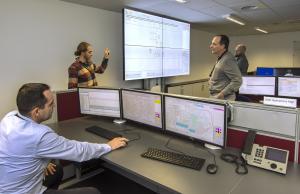The waking of the beast
The beast had sat immobile for more than three years—no blood running in its veins, no electrical impulse shaking its nerves alive. With three long horns sticking out of its squat body, it was just waiting for the moment it would be "energized."
The beast is one of three identical triplets—three massive electrical transformers that connect the 400 kV switchyard to the substations delivering pulsed power to various "clients" in the ITER installation. Procured by China and installed by Europe, weighing close to 500 tonnes and towering 15 metres above ground, they are the largest electrical components of the project.
By Tuesday morning, the beast was ready to be awakened. In the temporary ITER control room (a vast, nondescript office space where computers already monitor the installation's operational systems), as well as in a building on the ITER platform close to the transformer and at the RTE dispatching centre 80 kilometres away in Marseille, signals and status diagrams flashed on the screens.



